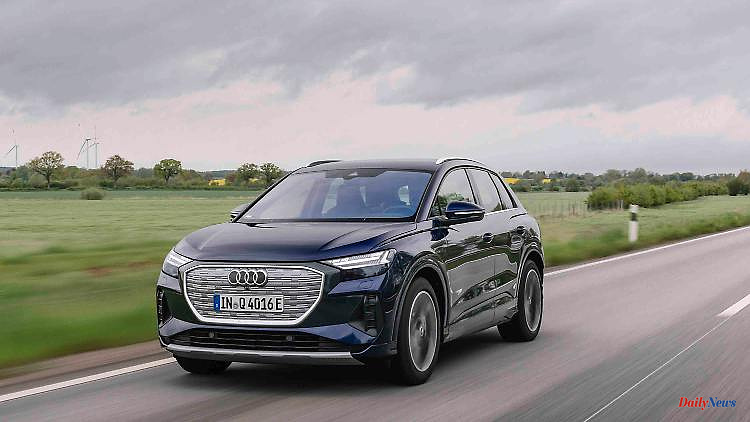With the Q4 E-Tron, Audi has an electric car for everyday use and mainstream in its range. If you don't mind taking a break, you can even go on long journeys with the Stromer. But it will probably not inspire those in a hurry. And the purchase price is not for smaller purses.
Electric cars often emphasize their differentness with progressive styling. Not so the Q4 E-Tron. The Stromer fits nonchalantly into Audi's current design DNA. Otherwise, the five-door feels like a normal everyday car with a certain premium touch. As a user, you only have to be willing to try new things on long journeys.
Like many other Stromers from the VW Group, the Q4 is also based on the MEB electrical kit. Thanks to the battery in the basement, MEB models are quite high, which is not particularly noticeable in the case of the Q4. At 1.63 meters, it is one centimeter higher than the Q3 positioned below it, but compared to the Q5 it is three centimeters flatter.
Although the interior impresses with chic Audi coloring, the constraints of the MEB world - such as brittle-looking hard plastic parts below the haptic perception area - cloud the positive impression. The space available in the 4.59 meter long Q4 is consistently good. The five-door spoils you with plenty of legroom and headroom in the front and rear. Unlike combustion Audis, the center tunnel is missing, which is why a third pair of feet can easily be accommodated in the rear.
The trunk is as you would expect from a compact SUV: spacious, classically variable and expanded. The charging cable fits under the removable shelf. Unusual for an Audi cockpit is the floating center console with a small slide switch for driving gear selection. Instead of actively starting the drive system, the driver simply sits down at the steering wheel and slides the controller to D. And off you go.
With the large 82 kWh battery, 77 kWh of which can be used, the Q4 40 we tested is suitable for long journeys. According to the WLTP protocol, the power storage even allows more than 500 kilometers. In practice, however, these are shorter, as was shown by a journey of around 330 kilometers from Cologne to Bremen. Although we started with a full battery and, according to the on-board computer, with a range of more than 400 kilometers, with cruise control 130, summer heat and activated air conditioning, 340 kilometers remained.
In order not to arrive with an almost empty battery, we headed for one of the many fast chargers that are now available along the freeways. A few minutes were enough to quickly set up a carefree buffer with around 80 kW charging power. Since no private charging facility was available at the destination, we had to go to a fast charger at a gas station there again. It also started with around 80 kW charging power, which decreases as the filling level increases. At 65 percent, for example, it was only 67 kW. Charging from 10 to 80 percent or 53 kWh took 44 minutes. The actually "quick" refueling can take a long time, although the Q4 with 135 kW could be faster.
We came much closer to this ideal value on the return trip. On the A1 towards Cologne, the navigation system recommended a stop at the EnBW rapid charging park in Kamen. Thanks to the preconditioned battery, the 300 kW HPC column sometimes sent 116 kW into the battery cells. Charging 45 kWh or 12 to 67 percent took 28 minutes. With a practical average consumption of 20 kWh per 100 kilometers, we have filled up a range of 200 kilometers in well under 30 minutes. However, without a preconditioned battery and a charge target of 80 percent, you should calculate more time.
Even if a Q4 40 E-Tron is basically suitable for long-distance use, you have to accept significantly longer "refueling breaks" on a long tour than with a combustion engine. Sometimes this can be annoying, sometimes pleasant. The EnBW charging park we visited, for example, is nicely laid out and equipped with a comfortable toilet, and there are also many food options around it.
The Q4 E-tron, unlike many other Audi models, is likely to be less inspiring for those in a hurry. Especially since, for reasons of efficiency, you drive 130 km/h rather than the maximum possible 160 km/h. Then the seductively powerful and always extremely cultivated Stromer remains reserved when it comes to energy costs. If you fill up on cheaper house electricity for 30 cents, 100 kilometers with a consumption of 20 kWh cost a good 6 euros. With the more expensive on-the-go electricity, you get about 10 euros, which is still a few euros cheaper than with a similarly motorized petrol engine.
The purchase price is less pleasing when it comes to costs. Around 45,000 euros are already being called for the base 35 E-Tron with a small 55 kWh battery, 52,000 euros for the 40 with a large battery and 150 kW/204 hp rear-wheel drive. If you tick a few boxes, you can quickly go beyond 60,000 euros. Our copy was 64,000 euros. environmental bonus? Since it will not be possible to get a new Q4 before 2023 due to the long delivery times, the subsidy of probably less than 5,000 euros will be the proverbial drop in the bucket rather than a rain of warm money.












